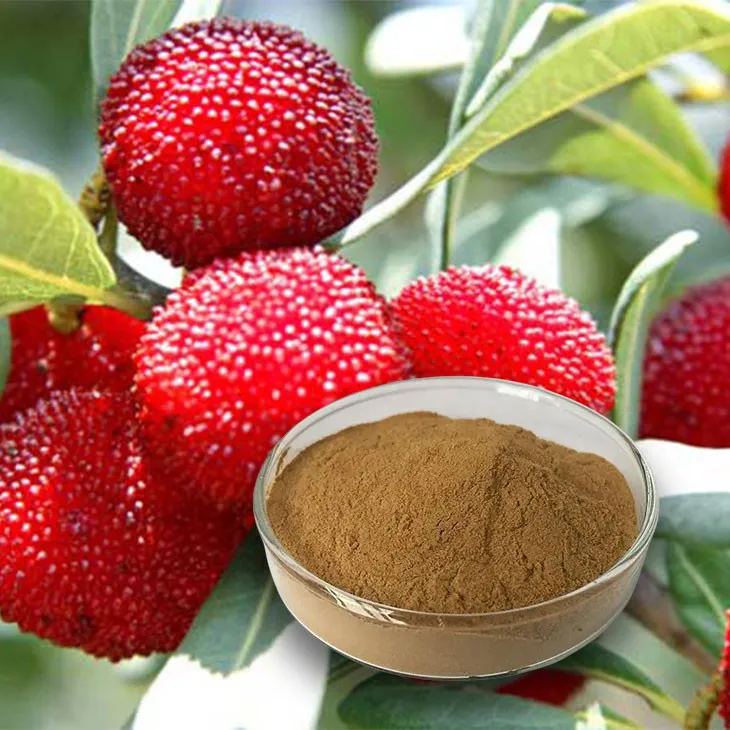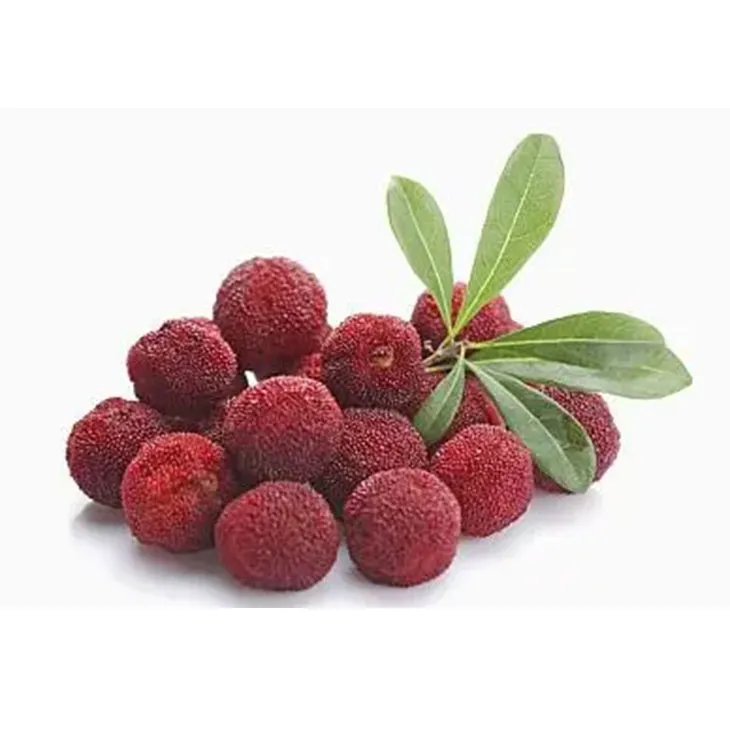- 0086-571-85302990
- sales@greenskybio.com
The process of extracting myricetin from bayberry extract.
2024-11-29

1. Introduction
Myricetin, a flavonoid compound, has been the focus of increasing attention in recent years due to its numerous potential health benefits. Bayberry, a common plant, contains myricetin in its extract. The extraction of myricetin from Bayberry Extract is not only of great significance in scientific research but also has broad application prospects in industries such as health - care products and nutraceuticals. This article will provide an in - depth look at the process of extracting myricetin from Bayberry Extract.

2. Bayberry: A Promising Source
2.1 Botanical Characteristics
Bayberry is a plant with unique botanical characteristics. It is often found in certain regions and has adapted to specific environmental conditions. Bayberry trees typically have certain growth habits, and their fruits possess distinct features. For example, the fruits are usually small and have a characteristic color and texture. These characteristics are related to the content and form of myricetin within the bayberry.2.2 Myricetin Content in Bayberry
The content of myricetin in bayberry varies depending on factors such as the variety of bayberry, the growth environment, and the ripeness of the fruit. Different varieties of bayberry may have different levels of myricetin. Generally, a proper growth environment, including factors like soil quality, sunlight exposure, and water availability, can promote the synthesis and accumulation of myricetin in bayberry. Additionally, as the bayberry fruit ripens, the content of myricetin may also change.
3. Pretreatment of Bayberry for Extraction
3.1 Collection of Bayberry
The first step in the extraction process is the proper collection of bayberry. Bayberry should be harvested at the appropriate time. If harvested too early, the fruits may not have fully developed, resulting in a lower content of myricetin. On the other hand, if harvested too late, the fruits may start to deteriorate, also affecting the quality of the extract. During the collection process, it is important to select healthy and ripe bayberries.3.2 Cleaning and Sorting
After collection, bayberries need to be thoroughly cleaned to remove dirt, debris, and other impurities. This can be achieved through simple washing procedures. Subsequently, sorting is necessary to separate damaged or unripe fruits from the healthy ones. Sorting helps to ensure the uniformity of the raw material for extraction and can improve the efficiency and quality of the extraction process.3.3 Drying or Freezing
Once the bayberries are cleaned and sorted, they can be either dried or frozen depending on the extraction method to be used later. Drying can be carried out using natural drying methods such as air - drying or artificial drying methods like using a drying oven. Freezing is another option, which can help to preserve the bioactive substances in the bayberry. Drying or freezing is crucial as it can affect the subsequent extraction process and the stability of myricetin.
4. The Extraction Phase
4.1 Selection of Solvents
The choice of solvents is a critical factor in the extraction of myricetin from Bayberry Extract. Aqueous - organic solvent mixtures are often effective. For example, a mixture of ethanol and water can be used. Ethanol has the ability to dissolve myricetin effectively, while water can help to adjust the polarity of the solvent system. Other solvents or solvent combinations may also be considered depending on the specific requirements of the extraction. The solubility of myricetin in different solvents is related to its chemical structure. Myricetin has both hydrophilic and hydrophobic moieties, so a suitable solvent system needs to balance these properties.4.2 Extraction Methods
There are several extraction methods available. One common method is maceration, where the pretreated bayberry is soaked in the selected solvent for a certain period of time. During this process, the solvent penetrates into the bayberry tissues and extracts the myricetin. Another method is Soxhlet extraction, which is a continuous extraction method. The bayberry sample is placed in a Soxhlet extractor, and the solvent is continuously refluxed through the sample, ensuring more complete extraction. Ultrasonic - assisted extraction is also becoming popular. Ultrasonic waves can create cavitation effects, which can enhance the mass transfer between the bayberry and the solvent, thus increasing the extraction efficiency.5. Separation of Impurities
5.1 Centrifugation
Once the initial extract is obtained, centrifugation is often used as a separation technique to remove impurities. Centrifugation works based on the principle of different densities of substances. When the extract is centrifuged, the heavier impurities will sediment at the bottom of the centrifuge tube, while the supernatant containing myricetin can be easily separated. The speed and time of centrifugation need to be optimized according to the characteristics of the extract. For example, a higher speed may be required for extracts with more viscous substances.5.2 Filtration
Filtration is another important method for impurity separation. Simple filtration using filter paper can remove larger particles of impurities. However, for more fine - grained impurities, membrane filtration may be necessary. Membrane filtration can be classified into different types according to the pore size of the membrane, such as microfiltration, ultrafiltration, and nanofiltration. These filtration methods can effectively remove impurities while retaining the myricetin in the filtrate.6. Purification of Myricetin
6.1 High - Performance Liquid Chromatography (HPLC)
High - performance liquid chromatography (HPLC) is a highly effective purification method for isolating myricetin in high purity. HPLC works based on the differential separation of components in a mixture as they pass through a stationary phase and a mobile phase. The myricetin in the extract can be separated from other substances based on its unique retention time in the HPLC system. By optimizing the parameters of the HPLC, such as the type of column, the composition of the mobile phase, and the flow rate, a high - purity myricetin can be obtained.6.2 Other Purification Methods
In addition to HPLC, there are other purification methods that can be used. For example, column chromatography can be used to separate myricetin based on its different affinities for the stationary phase in the column. Recrystallization is another method, where the myricetin - containing solution is cooled or evaporated to allow the myricetin to crystallize out in a purer form. These methods can be used alone or in combination with HPLC to achieve a higher degree of purification.7. Characterization and Quality Control
7.1 Characterization of Myricetin
After purification, it is necessary to characterize the obtained myricetin. This can be done through various spectroscopic methods such as ultraviolet - visible spectroscopy (UV - Vis), infrared spectroscopy (IR), and nuclear magnetic resonance spectroscopy (NMR). UV - Vis spectroscopy can be used to determine the absorption characteristics of myricetin, which is related to its chemical structure. IR spectroscopy can provide information about the functional groups in myricetin. NMR spectroscopy can give detailed information about the atomic structure and chemical environment of myricetin.7.2 Quality Control
Quality control is crucial in the extraction of myricetin from bayberry extract. Parameters such as the purity of myricetin, the presence of residual solvents, and the content of other impurities need to be monitored. Purity can be determined by methods such as HPLC. Residual solvents can be detected using gas chromatography (GC). The content of other impurities can be analyzed by various analytical techniques. Strict quality control measures ensure that the extracted myricetin meets the requirements for applications in health - care products and nutraceuticals.8. Conclusion
The extraction of myricetin from bayberry extract is a complex but promising process. From the pretreatment of bayberry to the final purification and quality control of myricetin, each step is crucial. The development of more efficient extraction, separation, and purification methods will continue to improve the yield and quality of myricetin. With the increasing demand for natural bioactive substances in various industries, the extraction of myricetin from bayberry extract is expected to gain more attention and development in the future.
FAQ:
What are the main steps in extracting myricetin from bayberry extract?
The main steps include the collection and pretreatment of bayberry. Then, suitable solvents such as aqueous - organic solvent mixtures are used for extraction. After getting the initial extract, centrifugation is carried out to remove impurities. Finally, high - performance liquid chromatography (HPLC) is used for purification to isolate myricetin in high purity.
Why is bayberry extract a good source for myricetin?
Bayberry extract is considered a good source for myricetin as it contains bioactive substances, from which myricetin can be effectively drawn out through proper extraction and purification processes.
What solvents are commonly used in the extraction of myricetin from bayberry extract?
Aqueous - organic solvent mixtures are commonly used. These types of solvents can effectively extract the bioactive substances from bayberry, which is an important step in obtaining myricetin.
Why is high - performance liquid chromatography (HPLC) used in the purification process?
HPLC is used in the purification process because it can isolate myricetin in high purity. It is an advanced purification method that can separate myricetin from other substances in the extract accurately.
What are the potential applications of myricetin extracted from bayberry extract?
The myricetin extracted from bayberry extract has potential applications in areas like health - care products and nutraceuticals. It can be used to develop various products with beneficial health effects.
Related literature
- Myricetin: A Dietary Molecule with Diverse Biological Activities"
- "Bayberry and Its Bioactive Compounds: Extraction and Potential Health Benefits"
- "Advances in the Extraction and Purification of Flavonoids from Natural Sources"
- ▶ Hesperidin
- ▶ Citrus Bioflavonoids
- ▶ Plant Extract
- ▶ lycopene
- ▶ Diosmin
- ▶ Grape seed extract
- ▶ Sea buckthorn Juice Powder
- ▶ Fruit Juice Powder
- ▶ Hops Extract
- ▶ Artichoke Extract
- ▶ Mushroom extract
- ▶ Astaxanthin
- ▶ Green Tea Extract
- ▶ Curcumin
- ▶ Horse Chestnut Extract
- ▶ Other Product
- ▶ Boswellia Serrata Extract
- ▶ Resveratrol
- ▶ Marigold Extract
- ▶ Grape Leaf Extract
- ▶ New Product
- ▶ Aminolevulinic acid
- ▶ Cranberry Extract
- ▶ Red Yeast Rice
- ▶ Red Wine Extract
-
Kupilu Extract
2024-11-29
-
Oyster Mushroom Extract Powder
2024-11-29
-
Chia Seed Powder
2024-11-29
-
Bilberry Extract
2024-11-29
-
Calendula Extract
2024-11-29
-
Cranberry Extract
2024-11-29
-
Polygonum multiflorum extract
2024-11-29
-
Ginger Extract
2024-11-29
-
Mulberry Extract
2024-11-29
-
Acerola Extract
2024-11-29





















